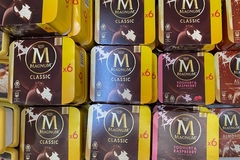
- Industry news
Industry news
- Category news
Category news
- Reports
- Key trends
- Multimedia
- Journal
- Events
- Suppliers
- Home
- Industry news
Industry news
- Category news
Category news
- Reports
- Key trends
- Multimedia
- Events
- Suppliers
Bluu Seafood’s cell-based sashimi and cultured fish products poised to make a splash in Singapore

10 Aug 2022 --- The first market-ready cell-based seafood products made from cultivated fish cells are edging closer to a Singapore launch, followed by the EU, US and UK. Bluu Seafood has presented its fish fingers and fish balls, which contain cultured protein as their main ingredient.
The new food prototypes have been enriched with plant proteins to optimize cooking behavior and mouthfeel. The launch of cell-based seafood comes amid a wave of activity within ocean-friendly products as Innova Market Insights’ Top Trend for 2022, “Shared Planet”, continues to influence R&D and innovation throughout the year.
“For the fish balls and fish fingers, the right flavor is provided by the cells and through a unique combination with the plant-based ingredients going into the product. Details are, of course, our trade secret,” Dr. Sebastian Rakers, CSO and co-founder of Bluu Seafood, tells FoodIngredientsFirst.

“We can say is that we spent quite some time getting to a pleasant texture using established food technology processes. A very important thing is that we do not add artificial flavors.”
 Cell-based fish balls (Credit: Bluu Seafood).Fresh catch of the future
Cell-based fish balls (Credit: Bluu Seafood).Fresh catch of the future
Bluu Seafood’s products will soon enter the regulatory approval process.
The company targets initial approval and market launch in Singapore by the end of 2023, as the regulatory process in the country is already well‐defined.
It will also apply for approval in the US, the UK and the EU.
“With the completion of our first products, we can demonstrate visible and edible results after less than two years of operational work,” continues Dr. Rakers. “This officially makes us the first company in Europe to produce cultivated fish. We are now working closely with regulatory agencies to clear the way for market launch and are using the time to focus on scaling.”
“We are currently in discussions with different potential partners in Singapore, therefore, the exact launch as well as specifications on labeling topics are yet to be determined. This is also heavily dependent on the progress on the regulatory side,” he details.
With the meatless movement set to reshape Asia’s playing field, Singapore serves as a veritable hub for the market’s cellular agriculture sector. The “garden city” is hailed as the first country in the world to approve the commercialization of cell-based chicken, attracting huge sums of investment from the likes of ADM and Ajinomoto into the new food category.
Next to Bluu Seafood, cell-based shrimp player Shiok Meats – which produces authentic shrimp meat processed for texture through 3D printers – is forecasting commercialization next year. “We are on track to bring the first shrimp product to market by 2023 via a premium restaurant in Singapore,” Shikha Malhotra, chief of staff to CEO at Shiok Meats, told FoodIngredientsFirst in a recent interview.
 Cell-based fish fingers (Credit: Bluu Seafood).Next-generation sushi
Cell-based fish fingers (Credit: Bluu Seafood).Next-generation sushi
In addition to fish balls and fish fingers, Bluu Seafood has also developed the first prototypes of more complex products such as filets and sashimi.
The company’s products use animal serum‐free growth media and are based on proprietary, non‐GMO trout and salmon cell lines. Conventional cell growth media – fetal bovine serum, in the case of most cell-based meat – has come under criticism not just for its high price, but for its composition of animal components.
“More complex products like filets and sashimi contain scaffolds plus different types of cells, e.g, muscle and fat cells, that need to be aligned and therefore require more production processes. We see that this translation from a piece being made at lab-scale toward an entire industrial process still requires some innovative work,” says Dr. Rakers.
“Although our technology will allow for local production, we do not envision a scenario where consumers can ‘print’ their own filet as the technology still requires a lot of know-how and expertise to create safe and healthy products.”
“We might add other products to the mix and other cell lines from different species in the future,” he notes.
 Shiok Meats is similarly targeting a launch in Singapore of cell-based shrimp (Credit: Shiok Meats).The future of meat
Shiok Meats is similarly targeting a launch in Singapore of cell-based shrimp (Credit: Shiok Meats).The future of meat
Industry’s conviction about the marketability of cell-based meat has led to significant firsts for the sector, including “ocean-free” cultured oysters, shrimp and even cultivated antelope from South Africa.
“Conventional seafood production has reached its limits as more than 90 percent of edible fish stocks are exploited to maximum levels, which poses a serious threat to marine ecosystems,” Rakers emphasizes.
Over the last year, the cell-based space has expanded into the premium category with the launch of cell-based marbled Wagyu ribeye beef.
As the movement gains traction, food companies, regulators, marketers, journalists and others have been highly encouraged to stick to the terms “cell-based” or “cell-cultured” when labeling or talking about cultivated meat products, according to a recent Rutgers study in the Journal of Food Science.
The genesis of the cell-based protein renaissance is, of course, met with the question of what will be left of conventional agriculture in the coming decades once the movement fully takes off.
A host of cell-based pioneers speaking to FoodIngredientsFirst previously underscored that cultured meat companies have a significant opportunity to collaborate with farmers at the early stages of production, involving them in cell sourcing and cell feedstock – rather than compete with them.
Exploring a different debate, FoodIngredientsFirst caught up with SuperMeat and cell-based firm Aleph Farms, alongside experts from the UK’s United Synagogue and the Islamic Chamber of Halal Certification Services, to explore how modern meat cultivation can be reconciled with long-held religious traditions.
By Benjamin Ferrer










